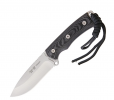trevitrace
Gold Member
- Joined
- Jul 21, 2013
- Messages
- 22,229
Utter nonsense for choppers, but hey, lug all that hand-impacting out of balance chopping weight if you want. Randall has never gone that route on big choppers for a reason. Big chopping knives do not have to be made of thin vibrating stock, while still fairly handle-heavy... The BK-9's 3/16" stock vibrated in my hand like there's no tomorrow, making any large task daunting, and one Youtuber observed, of the Esee Junglass, that the balance point made it feel "like it was designed on a computer", which of course it likely was... (see 9:18):
The huge 10.5" Junglass balances a pitiful 1/4" to 1/2" into the blade: Even my $39 Master Cutlery Rambo clone, at 10" and with a much pointier blade, balances in at over 3/4": The cheap Rambo clone is a better chopper than my Bk-9, although maybe not better than the 1" longer and much heavier Esee: 22.5" ounces vs only 17 ounces for the Master Cutlery does count: A pretty big 5.5 ounces... For maybe slightly better steel, find an older United Cutlery in supposedly similar 420: I rate those as more finely made and less chippy than the original D-2 Liles...
And yes, as long as the tube handle attachment method holds, short hollow handle tangs are less prone to breakage than long rat tails (for the obvious reason that a short piece is harder for vibrations to break than a long one)... The "Wiggy's Wilderness" video posted higher up this page shows clearly the tang is quite massive, and also quite intact, and that's a for $19 knife: A preventive dab of G-flex before the pin gave out, maybe even after, and that $19 knife probably would have held on forever, while also being impervious to rust...
With resin-epoxy attached tangs, like all the cheap United Cutlery Rambo clones, and many Randall rat tails and half tangs, the worst that ever happens is a slight guard rattle, easily cured with a fillet of crazy glue. I had a Randall Model 12 that shed its guard silver soldering after 1000 chops, leading to guard rattle, and a running of thin crazy glue around the guard cured it for the next 2000 chops, basically forever.
And yes, many Randalls hold on solely through a tiny dab of resin glue around a short stubby 3/4" tang, not even getting the mechanical hold of a lined lanyard hole: The full Micarta handle Clinton daggers for instance. Same for all the Gerber Mark IIs and Guardians ever made. I'm sure Randall and Vietnam vets didn't have a clue what they were doing.
Gaston
Of all your chopping tests I was most swayed by your evaluation of that Al Mar folder. Keep up the good fight, G.








